Abstract
Human factors play a critical role in underground mine evacuations, significantly impacting performance during emergencies. Traditional mine evacuation strategies rely on predetermined routes and static signs, but these methods do not account for the dynamic and unpredictable nature of real emergencies or the diverse behaviors of individuals. This research addresses these limitations by using agent-based simulations to explore evacuation behavior and performance in underground mines. The study involved three key steps. First, agent-based simulations were deployed to model both individual and group behaviors during emergencies. Second, evacuation performance was compared across three scenarios: miners following traditional passive signage, those making decisions in chaotic conditions, and miners equipped with smart evacuation devices. Finally, evacuation times were quantified to assess the effectiveness of each approach. The results revealed that miners using smart devices improved evacuation efficiency by 35% compared with those relying on passive signage and by 37% compared with chaotic decision-making scenarios. The median evacuation time was reduced from 10.8 min with passive signage to 7 min when using smart devices, taking varying stamina levels into account. These findings underscore the importance of integrating intelligent systems that account for pre-evacuation and wayfinding behaviors, offering new insights and setting a higher standard for emergency protocols in underground mining.
1. Introduction
Individuals are in danger when an emergency occurs in an environment that is not suited for making sound judgments during an evacuation. People may react unpredictably to panic and chaos, prioritizing immediate safety and moving to what they perceive as a safe location. However, this is not always the best way to exit an emergency situation. Measures must be developed to guide individuals to evacuate in a timely and effective manner to ensure safety [1]. Although the mining industry has made significant strides in enhancing safety, it remains one of the most hazardous industries worldwide [2]. Therefore, it is imperative that the industry adopt additional measures to prevent or alleviate hazards [3]. However, the health and safety of miners have improved significantly over time. According to the latest data from NIOSH depicted in Figure 1, there has been a decline in both fatality and injury rates, despite a persistent rise in production [4]. Nevertheless, further enhancements and initiatives are essential to achieve and maintain a “zero incident” operation [5].
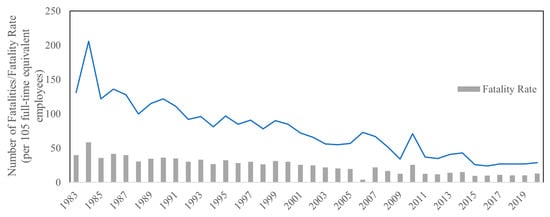
Figure 1.
Number of fatalities and fatality rates [4].
The mining industry has implemented several safety measures to improve the evacuation process during emergencies. Although traditional methods have been replaced by more advanced technologies to reduce the risk of accidents and enhance evacuation times, the success of an evacuation depends not only on technology but also on miners’ behavior, social interactions, and the speed of information transmission during an emergency.
Although optimizing evacuation routes plays a crucial role in emergencies, modeling evacuation behavior and individual movement is a challenging endeavor. Psychological, social, and environmental factors influence people’s decision-making in emergencies. There are two significant research challenges in the evacuation process and analysis: (1) integrating the effect of individuals’ adaptive behavior and (2) simulating complex evacuation scenarios that involve large crowds at the individual level, given the high complexity of the process [6]. Operational research often employs simulation models to represent real-world systems and evaluate scenarios across a range of behaviors. This is often accomplished using discrete event simulation (DES) and agent-based simulation (ABS) [7]. DES is normally used for simulating large-scale evacuations from hazardous situations, while ABS is favored for examining individual behaviors during evacuation scenarios. Models that incorporate adaptation and learning mechanisms are particularly valuable for the development and evaluation of evacuation strategies. ABS is a versatile tool applicable across various contemporary life domains, including biological and social systems, as well as physical systems that involve humans. For example, ABS can simulate extinct societies or establish markets for yet-to-be-introduced products and services [8]. The suitability of ABS for simulating human behavior lies in its ability to characterize interactions between individuals, the impact of these interactions on individual perceptions and desires, and the inherent uncertainty of such processes at an individual level rather than at a population level. ABS also enables the formal depiction of social interactions among individuals with diverse attributes, while facilitating the examination of social network configurations [9].
The use of simulation techniques for evacuation purposes has widely been adopted in different industries. Zhang et al. [10] developed an agent-based discrete event simulation for transportation evacuation based on a hybrid continuous and cell space. Filippoupolitis et al. [11] employed distributed building evacuation simulators to simulate a system representing the individual, intelligent, and interacting agents that cooperate and compete while evacuating the building. Yu et al. [12] proposed a dynamic evacuation simulation structure for a hazardous gas diffusion scheme by integrating dynamic analysis models into the geographical information system (GIS). Zarboutis and Marmaras [13] utilized agent-based simulation as the cognitive tool for designing formative evacuation plans for complex socio-technical system crises. Sun and Turkan [14] developed a fire dynamic simulator and the ABS to mimic how fires spread and how effectively people evacuate from different types of buildings. Yin et al. [15] utilized an agent-based travel demand model system to simulate a hurricane evacuation. These studies demonstrate that leveraging advanced simulation techniques like DES and ABS can significantly enhance the analysts’ understanding of evacuation processes, ultimately leading to more effective and adaptive evacuation strategies in various emergency scenarios.
1.1. Human Evacuation Behavior Modeling
Understanding human behavior during an emergency can help improve emergency management and safety planning. The first model of human behavior is the “panic” model, which holds that escape entails a homogeneous population of individuals with a loss of self-control and an emphasis on self-preservation [16,17]. However, even Quarantelli [18], who first articulated a cogent panic theory, maintained that “panic” was exceedingly rare in emergencies and disasters; for decades, the idea that people panic has been a widely held but disproven myth [19,20]. Since the 1950s, numerous researchers have investigated hypotheses regarding human behavior in situations of extreme duress. In the most recent classification, as depicted in Figure 2, Lin et al. [16] classified human activity into four categories: pre-evacuation behavior, wayfinding behavior, interaction behavior with others, and interaction behavior with the environment.
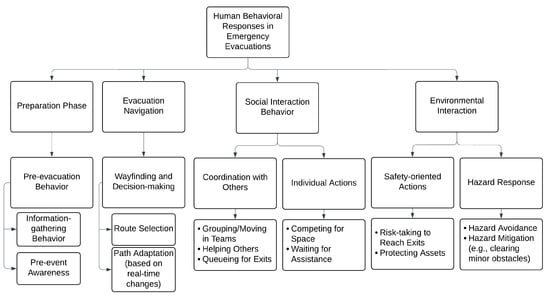
Figure 2.
List of human behaviors [16].
The pre-evacuation phase is crucial for survival as it determines the critical reaction time for evacuation. The pre-evacuation is divided into pre-event activity and information-seeking behavior. People tend to continue their behavior even after receiving emergency cues, and providing adequate information about the situation can increase their search for additional details. The evacuation time is often determined by individual characteristics like risk tolerance and value placed on pre-event activities. General situational factors like pre-event commitment, information availability, and felt time constraints also influence risk perception. Several theoretical approaches have been developed to explain human risk perception before evacuation. These approaches suggest that people need to receive and analyze emergency cues to make a sufficiently high-risk judgment before commencing evacuation [16,21,22].
To evacuate quickly and safely, individuals must navigate to the designated destination, a process known as wayfinding, which can significantly affect evacuation performance and survival in a fire. Wayfinding is influenced by various factors, including structure design and layout, signage systems, availability of vertical mobility, human factors, and social variables. One notable social variable is the herding phenomenon, where people tend to move in groups during a crisis. This behavior can affect wayfinding [16,23]. However, research indicates that individuals do not always follow their peers unless they face significant ambiguity and lack of evidence on which to base their own decisions. Thus, herding behavior may simply be the result of individuals making similar decisions based on the same information [24]. The behavior of individuals during an emergency, such as their interactions with others, can have a significant impact on evacuation performance [25]. Positive interactions, such as assisting those with disabilities, are prevalent during emergencies. However, negative interactions, including competitiveness, can prolong the evacuation process and cause physical injuries. Queuing, while a norm-abiding conduct, can also lead to negative consequences, such as blocking exits and causing trampling. Moreover, pre-existing relationships can influence evacuation behavior, as people may refuse to evacuate if it means leaving family members or close friends behind [16,26,27,28,29,30,31].
Furthermore, the way people interact with their environment significantly influences their safety. According to recent studies, people are more likely to take risks when they perceive the danger to be low or when they observe their neighbors taking comparable risks [32,33]. Moreover, during emergencies, individuals often attempt to protect their possessions, even if doing so puts them at risk of harm. When people believe their possessions are indispensable to their livelihood or irreplaceable, this conduct is more common. Furthermore, some individuals might go back to a disaster site despite warnings to retrieve property left behind after evacuation [16,31,34].
1.2. Current Underground Mine Evacuation Strategies and Technologies
The mining industry has made significant strides toward its goal of reducing the number of injuries and fatalities on the job. Various methods have been developed to ensure mines’ safety. All these techniques aim to address at least one of the following: effective communications, real-time position monitoring, navigation, etc. The release of stench gas is one of the oldest mine warning techniques, but it has limitations such as its slow response and unreliability and the potential for miner debilitation due to the odorant’s toxicity [35,36]. Detection and warning systems, such as real-time and high-resolution rock mass crack detection, coupled with radio and messaging systems, are more effective at alarming miners of threats, such as fires and rockfalls, and improving evacuation performance [37]. However, even with technological advancements, there is still no guarantee that miners will comply with evacuation orders. Wireless communication and electronic tracking technologies, such as RFID, Wi-Fi, and WSN, have been developed for precise location tracking of miners and to ensure rapid response during emergencies [35,38,39,40].
The traditional method for marking escape paths in underground mines uses signs, symbols, and maps, but it suffers from poor visibility in hazy environments. Various pathfinding and optimization algorithms, such as Dijkstra’s, Floyd–Warshall, and integer programming models, have been utilized to determine the ideal escape route in the event of an emergency [41,42,43,44]. MineSafe, an application that can run on smartwatches, is designed to enable two-way communication, track miners, identify and predict potential hazards, receive real-time event reports, and provide automated safety recommendations during emergencies [35,45]. Virtual reality (VR) technology is now being used for training miners on mine evacuation protocols, safety knowledge and awareness, self-rescue, danger assessment and avoidance, and disaster escape [46]. The current VR training systems for the mining industry can be categorized into three types based on the input/output devices employed by the VR system, which are screen-based general type, the projector-based customized type, and the head-mounted display (HMD)-based intuitive type [47]. The use of VR simulations has been shown to improve learning and comprehension of complex topics, save training time, enhance efficacy, and reduce the cost of education. The isolation of mining, particularly underground, makes it essential for miners to be prepared for emergencies [48,49,50,51,52,53]. Research shows that while training and preparation can reduce the chances of unfavorable outcomes, they may not eliminate them entirely. Proper training is critical for a prompt and effective emergency response. Detecting the fire hazard, identifying it accurately, and having competent responders are necessary for safely extinguishing a mine fire. It is crucial for miners to be well prepared for unforeseen eventualities, and thus, emergency preparedness and response are important for mine safety [35]. However, all these methods fail to address the human behaviors that could impact the evacuation behavior of evacuees.
2. Scope and Objectives
Despite the availability of modern evacuation methods, their efficacy is limited in underground mines by the range of human behaviors exhibited by miners during emergency situations. This study addresses this gap by providing insights into mine evacuation practices, identifying potential behavioral constraints, and proposing solutions to these constraints. The proposed approach employs a novel ABS to capture a wide range of miner dynamic behaviors during evacuations, providing a realistic modeling environment and assessing evacuation performance under multiple scenarios. Simulation scenarios are conducted to examine the effectiveness of the technology and understand potential human factors. The ABS evaluates and optimizes mine evacuation policies and procedures, including the development of evidence-based guidelines for emergency drills, evacuation route planning, and miner training programs. Additionally, ABS-based training procedures for miners and emergency responders provide immersive, interactive experiences that improve preparedness and response times during real emergencies. The contributions of the study are summarized as follows:
- Conducting a comprehensive analysis of human behaviors during mine evacuations, identifying and evaluating key behavioral constraints overlooked by previous studies;
- Developing ABS, as an advanced simulation technique for dynamic and realistic circumstances, to model and optimize the evacuation process;
- Implementing an empirical data-driven method for simulating evacuation scenarios and incorporating real-world data on walking and running speeds under various conditions to provide a robust framework for examining and optimizing underground mine evacuation strategies;
- Evidence-based decision-making for individuals’ safety in underground mines by addressing the human factor in mine evacuations and creating more effective and adaptive evacuation protocols.
3. Materials and Methods
This study proposed a comprehensive framework for analyzing and optimizing the impact of human factors in the underground mine evacuation process to save miners’ lives. This approach captured individual behaviors and interactions in complex underground mine environments, identifying bottlenecks to optimize procedures during evacuation emergencies. Figure 3 depicts the proposed step-by-step methodology for the evacuation process in this study.
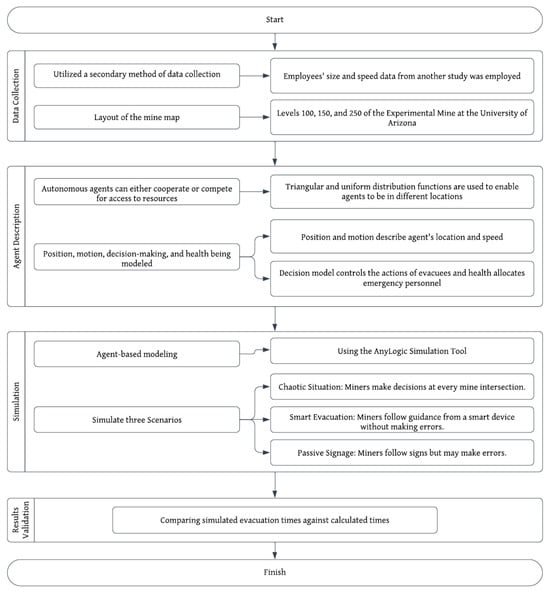
Figure 3.
The step-by-step procedure proposed for the study.
Data Collection. The proposed methodology began with data acquision. This study utilized secondary data, specifically information about walking and running speeds in various situations, as well as body size and speed data. This information was obtained from the study conducted by Liu et al. [54] to enhance the realism of the simulation. This information was on the speed, step frequency, and stride length of young and old adults, segmented by sex, for both flat surfaces and stairs. For young adult females, the body radius was 0.24 ± 0.02 m, with a speed of 1.45 m/s on flat surfaces and 0.65 m/s on stairs. Their step frequency remained at 2 steps per second on flat surfaces and 1 step per second on stairs, with stride lengths of 0.71 m and 0.66 m, respectively. Young adult males had a body radius of 0.27 ± 0.02 m and moved at 1.48 m/s on flat surfaces and 0.81 m/s on stairs, maintaining a step frequency of 2 steps per second on flat surfaces and 1 on stairs, with stride lengths of 0.76 m and 0.81 m. Among older adults, females had a body radius of 0.25 ± 0.02 m, moving at 0.93 m/s on flat surfaces and 0.56 m/s on stairs, with a consistent step frequency of 2 steps per second on flat surfaces and 1 on stairs and stride lengths of 0.46 m and 0.56 m. Finally, older adult males, with a body radius of 0.25 ± 0.02 m, exhibited speeds of 1.06 m/s on flat surfaces and 0.60 m/s on stairs, maintaining the same step frequency as the other groups, with stride lengths of 0.56 m on flat surfaces and 0.61 m on stairs. Additionally, the mine layout, provided as a CAD file, was sourced from the Experimental Mine at the University of Arizona. This CAD file was used to generate the final mine map, as illustrated in Figure 4.
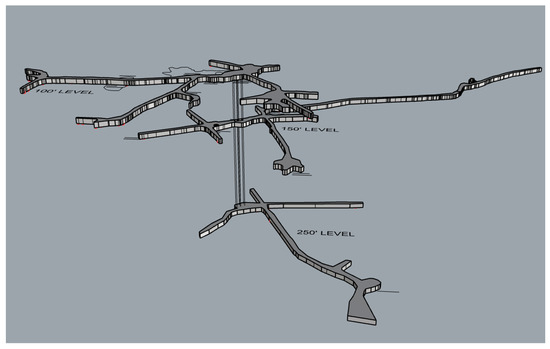
Figure 4.
Underground mine layout showing levels 100, 150, and 250.
The mine employed in this study belonged to an underground mine environment and focused on levels 100, 150, and 250. These levels were connected by a shaft, and other levels like the adit level were omitted due to their lack of connectivity.
Agent Description. Agent description was the second step of the proposed methodology. Agents were part of the simulation model, representing the underground miners. They could either cooperate or compete for access to resources, with their fundamental properties such as position, motion, decision-making, and health being modeled. Also, the logic in the simulation model outlined the specifications and interactions executed by each agent type. In this underground mine, the simulation model was configured based on autonomous agents who made individual decisions about resource utilization. Furthermore, the position and motion model described the agent’s location in the mine model and speed, while the decision model aimed to control the actions of evacuees and health allocates emergency personnel.
In this study, agent-based simulation modeling and configuration were implemented using AnyLogic PLE software, which was designed for simulating complex systems across various industries, including mining. Its agent-based approach allows for the modeling of individual entities (agents) that interact within their environments, making it especially valuable for understanding dynamic behaviors such as those involved in underground mine evacuations. AnyLogic combines three modeling paradigms—discrete event simulation, system dynamics, and agent-based modeling—giving users the flexibility to select the best approach for their scenarios.
The software features a comprehensive library of drag-and-drop elements that streamline model creation. Users can access predefined blocks representing different entities, such as miners or equipment, and define the spatial layout of the model using environment blocks. Process flow blocks facilitate the modeling of agent movements and interactions, while event blocks handle simulation triggers and responses, and decision-making blocks allow agents to adapt to changing conditions. Additionally, AnyLogic offers robust tools for analysis and visualization, including 3D visualization for spatial understanding, data analysis to identify bottlenecks, and experimentation capabilities for testing various strategies. The integration features further enable real-time data input and output with other systems, making AnyLogic a powerful platform for modeling and optimizing complex processes in underground mine evacuations [55].
As depicted in Figure 5, the pre-incident decision model randomly positioned miners in various locations throughout the mine. The evacuation decision model, shown in Figure 6, considered the reaction time during the pre-evacuation phase. Triangular and uniform distribution functions were used to enable agents to be in different locations over time, and the activities were overridden when the evacuation was initiated.

Figure 5.
Constructing pre-incident model.

Figure 6.
Constructing evacuation model.
Simulation. The next step revolved around the development of evacuation scenarios and evaluation of simulation model. In this study, three different scenarios were generated to examine the effects of pre-evacuation and wayfinding behaviors on evacuation performance. These scenarios included a chaotic situation, smart evacuation, and passive signage. All miners evacuated on foot, and their body size and speed were based on the described data in the data collection part. The minimum-cost network flow algorithm was utilized to determine the optimal evacuation path. In AnyLogic, each evacuee could be modeled as an agent capable of navigating a network of paths. To achieve this, custom Java code was implemented to calculate the optimal path for each agent, and the resulting routes were then assigned to guide their movements. In an emergency in an underground mine, this algorithm calculated miners’ distances to each “safe location” and directed them to the nearest one. This approach minimized the evacuation time and cost by identifying optimal escape routes, making it an effective solution for mine safety scenarios. The mathematical formulation of this algorithm was defined as follows:
where is units of flow from node i to node j along arc (i,j), is the cost per unit of flow on arc (i,j), A is the set of all arcs (i,j) in the network, N is the set of nodes in the network, and is the net supply or demand at node i.
This study examined various scenarios and cases with parameters such as pre-evacuation delay, intersection delay, and error probability to analyze the impacts of stamina and guidance on evacuation performance. Three distinct scenarios were defined: chaotic, smart evacuation, and passive signage, each characterized by unique levels of inherent delay and error probability. These inherent delays and error probabilities distinguished the scenarios at the outset. Then, the analysis process was conducted by introducing variations in error probability and delays through sensitivity analysis. The details of each simulation scenario were as follows:
- Chaotic Situation: Miners made decisions at every mine intersection. This scenario featured two cases:
- Case 1: Examining evacuation time while increasing the probability of errors;
- Case 2: Introducing pre-evacuation delays and delays at intersections, with increasing error probability and variable miner speeds to examine the effect of stamina on the evacuation times.
- Smart Evacuation: In the smart evacuation scenario, miners were guided by a smart device that eliminated human error by providing real-time, optimized escape routes. A real-time optimization algorithm continuously directed each miner to the safest, nearest shelter based on their current location, any path blockages, available routes, distance to shelters, and individual stamina levels. This guidance was updated dynamically for each person, addressing changing conditions underground. The optimization model underlying this process was designed to solve the minimum-cost network flow algorithm, ensuring that miners reached safety efficiently and with minimized evacuation time. This scenario also featured two cases:
- Case 1: Introducing pre-evacuation delays;
- Case 2: Operating without pre-evacuation delays.
Both cases were run for miners with uniform and variable stamina, achieved through different speeds for each miner.
- Passive Signage: In traditional underground mine evacuation scenarios, miners rely on passive signage to navigate toward safe exits. These signs are typically static indicators—such as arrows, illuminated signs, or color-coded paths—that mark designated escape routes. While passive signage is simple and cost-effective, it lacks the ability to adapt to real-time conditions like changing hazards, blocked pathways, or individual miner locations. Consequently, in emergencies with complex or evolving conditions, traditional signage may lead to delays or confusion as miners must interpret and follow predetermined routes that may no longer be optimal. Despite these limitations, passive signage remains a fundamental component of safety protocols and is often combined with training to ensure miners are familiar with evacuation routes. This scenario included the following:
- Single Case: Keeping pre-evacuation delay constant while varying the delay at intersections and the error percentage.
It was run for miners with both uniform and variable stamina, with differences in stamina achieved by varying speeds.
To simplify the simulation model, some assumptions were made, including the following:
- All miners had the same role.
- There was no interaction between the miners and the environment.
- Only wayfinding and pre-evacuation behaviors were considered.
- Wayfinding and pre-evacuation behaviors were treated as delays.
- All miners evacuated on foot.
- All miners followed the evacuation plan in the smart evacuation scenario; however, their behavior may vary.
- The evacuation time was defined as the time it took for the last miner to leave the mine.
Validation. The last step of the proposed methodology was focused on validating the simulation results. The model’s validation involved comparing simulated evacuation times against calculated times based on predefined miner speeds and the physical layout of the mine. This comparison helped confirm the accuracy of the simulation model in predicting realistic evacuation outcomes. The primary outcome measure was the evacuation time, with additional analysis focusing on the influence of individual and collective behaviors on the efficiency of different evacuation strategies. The study aimed to identify key factors that significantly impacted evacuation time and safety, informing the development of more effective evacuation protocols and training programs for mine safety.
4. Results and Discussion
This section presents the results and discusses the key factors influencing the underground mine evacuation process. The ABS was developed and executed using the AnyLogic PLE Simulation Tool. AnyLogic eschews traditional simulation modeling paradigms in favor of software engineering techniques and languages. Its object-oriented core language manages complexity effectively, enabling the construction of robust agent-based models within a unified visual environment. This study incorporates critical features such as agent behavior structures and communication pathways to accurately represent the system. The simulation scenarios were designed to model the evacuation of 24 individuals during emergencies, with the model being run 50 times for each state to ensure accurate calculations of the average evacuation time per person. This average evacuation time per person was determined by calculating the evacuation time for each simulation run, based on the time of the last evacuee to exit. For each group of 24 evacuees, an average evacuation time was calculated, and this process was repeated over 50 runs. By fitting a standard distribution function to these average values, we obtained a reliable measure of the overall average evacuation time per person across all runs. Additionally, the number of shafts and refuge chambers was set to one.
4.1. Scenario 1: Chaotic Situation
The configurations in Table 1 and Table 2 were used in the simulation of cases 1 and 2, respectively. Case 1 examined the evacuation time while increasing the probability of errors. Conversely, case 2 explored the impact of pre-evacuation delays and delays at intersections, alongside an increasing error probability.

Table 1.
Parameters for case 1 of a chaotic scenario.

Table 2.
Parameters for case 2 of a chaotic scenario.
The simulation of case 1 assessed the average evacuation time when errors were introduced during an emergency. The results indicated that the average evacuation time per person increased considerably for the first few configurations and then stabilized irrespective of further errors. These findings suggested that a mistake by even one miner during the evacuation could have a significant effect on the overall evacuation performance. Additionally, there was a significant increase in evacuation time when miners had varying stamina levels (Figure 7).
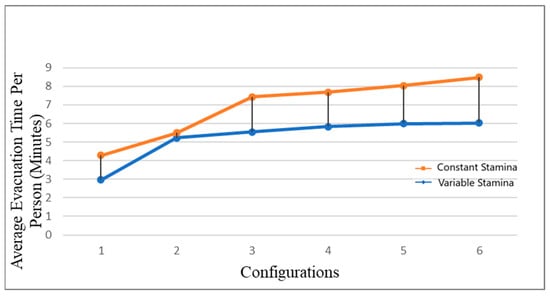
Figure 7.
Average evacuation time for a chaotic scenario with an increase in error.
The simulation of case 2 aimed to examine the effects of pre-evacuation delay, intersection delay, and increased error probability on the evacuation time. The results, presented in Figure 8, demonstrated a linear increase in the average evacuation time as the pre-evacuation delay, intersection delay, and error percentage increased. This trend was observed in simulations with both uniform and varied stamina levels. However, different stamina levels led to a significant spike in the average evacuation time for each configuration. Therefore, delays in evacuation decisions, increased intersection delays, and the introduction of errors during evacuation could significantly impact the evacuation performance. Additionally, the stamina of the miners also influenced the process.
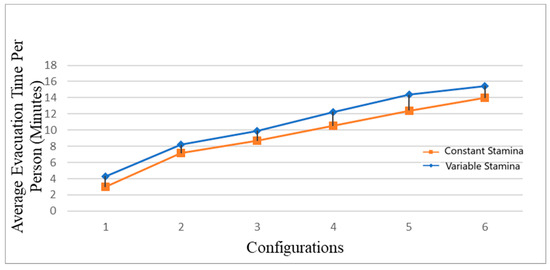
Figure 8.
Average evacuation time for a chaotic scenario with an increase in pre-evacuation time.
4.2. Scenario 2: Smart Evacuation
The configurations in Table 3 and Table 4 were used in the simulations of case 1 and case 2, respectively. This scenario comprised two distinct cases: case 1 introduced a pre-evacuation delay, whereas case 2 involved no pre-evacuation delay. In both cases, the evacuation performance was evaluated based on the time required to evacuate all miners safely. Additionally, the effect of varying stamina was analyzed in both cases.

Table 3.
Parameters for case 1 of the smart evacuation scenario.

Table 4.
Parameters for case 2 of the smart evacuation scenario.
The objective of case 1 in the smart evacuation scenario was to evaluate the impact of pre-evacuation and intersection delays on the evacuation performance, assuming no mistakes or errors during evacuation. It should be noted that in this case, delays at intersections were constant. The study assessed the time required to safely evacuate all miners from the mine. The results showed a gradual increase in the average evacuation time as the pre-evacuation delay increased, under conditions of both uniform and varying stamina, as illustrated in Figure 9. These findings highlight the importance of effective pre-evacuation strategies in ensuring the prompt and successful evacuation of miners in emergencies. They also underscore the need for appropriate training and education of miners on evacuation protocols and the proper use of smart devices to minimize the pre-evacuation delay and enhance the overall evacuation performance.
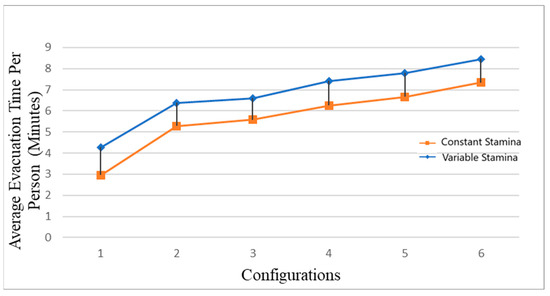
Figure 9.
Average evacuation time for smart evacuation scenario case 1 with an increase in pre-evacuation time.
Case 2 of the smart evacuation scenario represented the ideal conditions for mine evacuation as it assumed no pre-evacuation delays, no delays at intersections, and no errors during the evacuation process. In this case, the evacuation performance was evaluated based on the time required to safely evacuate all miners. The results indicated a significant increase in the average evacuation time when variable stamina was employed compared with constant stamina, with a 31% increase as illustrated in Figure 10. This underscores that stamina plays a critical role in the evacuation performance, and the presence of varying stamina levels among miners can notably impact the overall evacuation time.
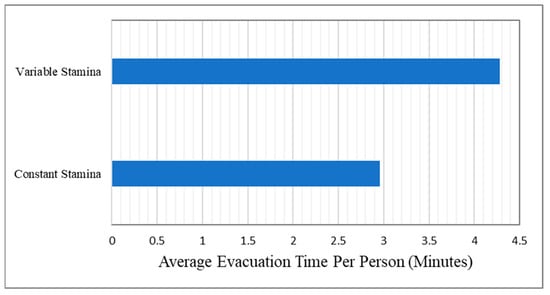
Figure 10.
Average evacuation time for the smart evacuation scenario without pre-evacuation time.
4.3. Scenario 3: Passive Signage
The impact of passive signage on evacuation performance was analyzed using the configuration presented in Table 5. The simulation focused on a single case where the pre-evacuation delay remained constant, but the delay at intersections was varied. This study evaluated average evacuation times for miners with uniform stamina and those with varying stamina levels.

Table 5.
Parameters for passive signage scenario.
According to the simulation results depicted in Figure 11, there was a gradual increase in the average evacuation time as the delay at intersections was increased for both groups of miners. In general, the longer the delay at intersections, the greater the increase in the average evacuation time. Additionally, the results shown in this figure are similar to those in Figure 9. However, in Figure 9, intersection delays are constant, while in Figure 11, pre-evacuation delays are held constant.
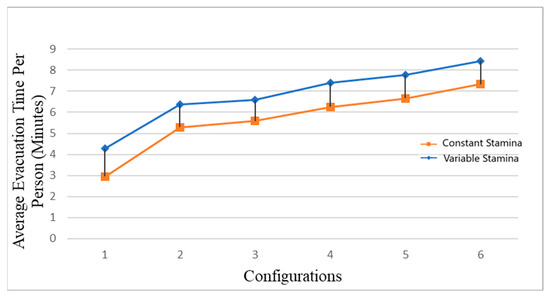
Figure 11.
Average evacuation time for the passive signage scenario with an increase in pre-evacuation time.
4.4. Comparison of Case 1 to Case 2 in Scenario 1
The observed results for all three levels indicated significant deviations from case 1 to case 2 for both constant and varying stamina as the pre-evacuation delay, intersection delay, and errors increased. This is demonstrated in Figure 12 and Figure 13. These findings suggest that delays during evacuation can substantially impact the evacuation process, particularly in terms of the time required to evacuate.
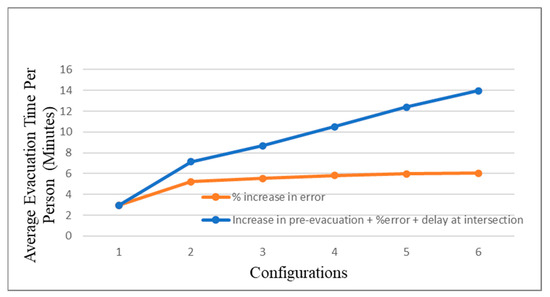
Figure 12.
Comparing case 1 and case 2 of the chaotic scenario for constant stamina.

Figure 13.
Comparing case 1 and case 2 of the chaotic scenario for variable stamina.
4.5. Comparison of Scenarios 1, 2, and 3
Three different scenarios were compared to investigate their impacts on the average evacuation time during a mine emergency. Scenario 1 considered delays due to pre-evacuation behavior and wayfinding; scenario 2 accounted for pre-evacuation delays when using a guidance device, while scenario 3 was similar to scenario 2 but included wayfinding delays.
In the case of miners with the same stamina, the average evacuation time was highest in the chaotic scenario (scenario 1), followed by the passive signage scenario (scenario 3), with the smart evacuation scenario (scenario 2) recording the shortest average evacuation time, as depicted in Figure 14. As shown in this figure, scenario 2 achieved the shortest median evacuation time, which remained around 6 min. In contrast, scenarios 1 and 3 yielded median times of 9.6 and 9 min, respectively. On the other hand, for miners with varying stamina, significant differences were observed between the three scenarios (Figure 15). Scenario 2 showed a high divergence from scenarios 1 and 3. Scenarios 1 and 3 exhibited insignificant differences. As shown in this figure, for evacuation times across different scenarios with varying configurations, scenario 2 demonstrated the most efficient evacuation process, with a median evacuation time of 7 min. Also, scenarios 1 and 3 reached median times of 11.1 and 10.8 min, respectively. In this analysis, the evacuation efficiency was evaluated using the smart evacuation scenario as the benchmark, comparing the median evacuation times of each scenario relative to it. The efficiency was formulated as . Accordingly, scenario 2 demonstrated evacuation efficiencies of 37% compared with scenario 1 and 35% compared with scenario 3.
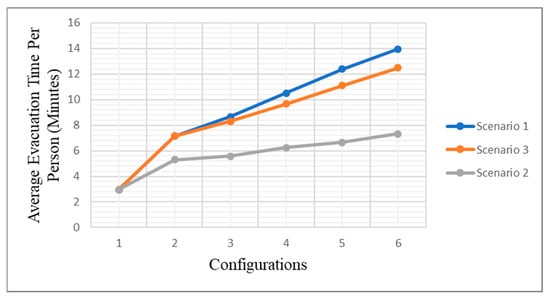
Figure 14.
Comparing scenarios 1, 2, and 3 for the same stamina.
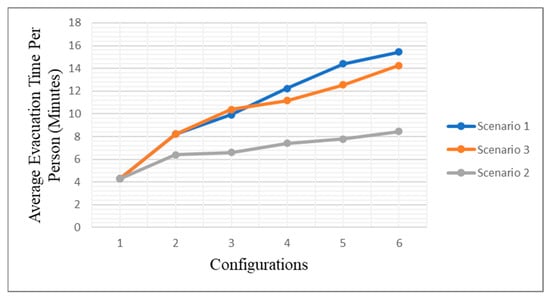
Figure 15.
Comparing scenarios 1, 2, and 3 for different stamina levels.
These results indicated that the smart evacuation scenario was the most effective method for evacuating a mine during an emergency, particularly for miners with varied stamina. In contrast, scenario 1, which included delays due to pre-evacuation behavior and wayfinding, was found to be the least effective scenario. These findings highlight the importance of considering various factors, such as pre-evacuation behavior, wayfinding, and stamina levels, that can affect the evacuation process during an emergency. Addressing these factors appropriately can lead to improved evacuation strategies and ensure the safety of all miners.
5. Validation of Results
The accuracy of evacuation models depends on empirical data validation to ensure accurate predictions. However, quantitative validations are rare and typically limited to small-scale studies [56]. The validation of this model relied on the total evacuation time. Since the mine layout was simple, the distance of selected miners with the longest distance to the exit, divided by a speed of 1.48 m/s, was used to estimate the best-case scenario evacuation time. The results from these manual calculations were comparable to the results obtained from the minimum-cost network flow algorithm developed by Meij et al. [41]. The average evacuation time obtained from the manual calculation was 2.702 min. After multiple simulation runs, the average evacuation time was 2.7022 min, as shown in Figure 16. The slight variance arose from the dynamics of the evacuation model and the location accuracy of miners in the evacuation model within the AnyLogic simulation platform.
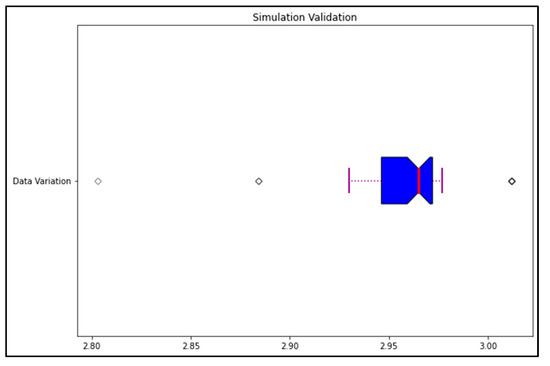
Figure 16.
Variations in the average evacuation time.
6. Conclusions
Since human behavior during emergencies significantly affects the individuals’ evacuation process outcomes in underground mining, this study focused on identifying, modeling, and analyzing individuals’ behavior during the evacuation process. The agent-based simulation technique was taken into account as one of the most efficient tools in configuring different scenarios and evaluating their results, which considered actual variables and parameters to provide realistic underground mining environment conditions. In this regard, three different scenarios were developed and evaluated, including people with chaotic decision-making, the use of traditional passive signage, and the use of smart evacuation devices. The chaotic scenario showed the need to avoid unpredictable errors to guarantee a fast and successful evacuation during emergencies because even a single error by one miner could drastically impair the evacuation performance. In larger mines, where conditions such as smoke or physical impediments are present, reliance on passive signage alone could significantly hinder evacuation efforts. Thus, comprehensive evacuation plans should be developed, and miners should be trained in evacuation procedures. A smart evacuation system that assesses miners’ stamina could optimize the evacuation procedure and guide them to safety. Future research could examine the effects of interaction behaviors, particularly the grouping effect, on mining evacuation performance. Additionally, investigating the use of virtual reality for miner training and developing a smart evacuation system that integrates pre-evacuation and wayfinding behaviors could significantly reduce evacuation duration.
Author Contributions
Conceptualization, J.S.; Validation, A.M.-M.; Investigation, P.C.A. and J.S.; Data curation, M.S.; Writing—original draft, P.C.A.; Writing—review & editing, A.M.-M. and M.S.; Project administration, J.S.; Funding acquisition, J.S. All authors have read and agreed to the published version of the manuscript.
Funding
This research was funded by the National Institute for Occupational Health and Safety (NIOSH) grant number 75D30119C06044.
Institutional Review Board Statement
Not applicable.
Informed Consent Statement
Not applicable.
Data Availability Statement
The raw data supporting the conclusions of this article will be made available by the authors on request.
Conflicts of Interest
The authors declare no conflicts of interest.
References
- Rendón Rozo, K.; Arellana, J.; Santander-Mercado, A.; Jubiz-Diaz, M. Modelling building emergency evacuation plans considering the dynamic behaviour of pedestrians using agent-based simulation. Saf. Sci. 2019, 113, 276–284. [Google Scholar] [CrossRef]
- Moniri-Morad, A.; Shishvan, M.S.; Aguilar, M.; Goli, M.; Sattarvand, J. Powered haulage safety, challenges, analysis, and solutions in the mining industry; a comprehensive review. Results Eng. 2023, 21, 101684. [Google Scholar] [CrossRef]
- Simpson, G.; Horberry, T.; Joy, J. Understanding Human Error in Mine Safety; CRC Press: Boca Raton, FL, USA, 2009. [Google Scholar]
- Centers for Disease Control and Prevention. Number and Rate of Occupational Mining Fatalities by Year, 1983–2022; Centers for Disease Control and Prevention: Atlanta, Georgia, 2022.
- Esterhuizen, G.S.; Gürtunca, R.G. Coal mine safety achievements in the USA and the contribution of NIOSH research. J. S. Afr. Inst. Min. Metall. 2006, 106, 813–820. [Google Scholar]
- Chen, D.; Wang, L.; Zomaya, A.Y.; Dou, M.; Chen, J.; Deng, Z.; Hariri, S. Parallel simulation of complex evacuation scenarios with adaptive agent models. IEEE Trans. Parallel Distrib. Syst. 2015, 26, 847–857. [Google Scholar] [CrossRef]
- Sumari, S.; Ibrahim, R.; Zakaria, N.H.; Hamijah, A.; Hamid, A. Comparing Three Simulation Model Using Taxonomy: System Dynamic Simulation, Discrete Event Simulation and Agent Based Simulation. Int. J. Manag. Excell. 2013, 1, 54–59. [Google Scholar] [CrossRef]
- Macal, C.M.; North, M.J. Agent-based modeling and simulation. In Proceedings of the Winter Simulation Conference, Austin, TX, USA, 13–16 December 2009; pp. 86–98. [Google Scholar]
- Boateng, M.K.; Awuah-Offei, K. Agent-based modeling framework for modeling the effect of information diffusion on community acceptance of mining. Technol. Forecast. Soc. Chang. 2017, 117, 1–11. [Google Scholar] [CrossRef]
- Zhang, B.; Chan, W.K.; Ukkusuri, S.V. Agent-based discrete-event hybrid space modeling approach for transportation evacuation simulation. In Proceedings of the Winter Simulation Conference, Phoenix, AZ, USA, 11–14 December 2011; pp. 199–209. [Google Scholar]
- Filippoupolitis, A.; Gelenbe, E.; Gianni, D.; Hey, L.; Loukas, G.; Timotheou, S. Distributed agent-based Building Evacuation Simulator. In Proceedings of the Summer Computer Simulation Conference 2008, SCSC 2008, Part of the 2008 Summer Simulation Multiconference, SummerSim 2008, Edinburgh, Scotland, 16–19 June 2008; pp. 46–53. [Google Scholar]
- Yu, Z.; Wang, J.; Luo, W.; Hu, Y.; Yuan, L.; Lü, G. A dynamic evacuation simulation framework based on geometric algebra. Comput. Environ. Urban. Syst. 2016, 59, 208–219. [Google Scholar] [CrossRef]
- Zarboutis, N.; Marmaras, N. Design of formative evacuation plans using agent-based simulation. Saf. Sci. 2007, 45, 920–940. [Google Scholar] [CrossRef]
- Sun, Q.; Turkan, Y. A BIM-based simulation framework for fire safety management and investigation of the critical factors affecting human evacuation performance. Adv. Eng. Inform. 2020, 44, 101093. [Google Scholar] [CrossRef]
- Yin, W.; Murray-Tuite, P.; Ukkusuri, S.V.; Gladwin, H. An agent-based modeling system for travel demand simulation for hurricane evacuation. Transp. Res. Part C Emerg. Technol. 2014, 42, 44–59. [Google Scholar] [CrossRef]
- Lin, J.; Zhu, R.; Li, N.; Becerik-Gerber, B. How occupants respond to building emergencies: A systematic review of behavioral characteristics and behavioral theories. Saf. Sci. 2020, 122, 104540. [Google Scholar] [CrossRef]
- Sime, J.D. Affiliative behaviour during escape to building exits. J. Environ. Psychol. 1983, 3, 21–41. [Google Scholar] [CrossRef]
- Quarantelli, E.L. The nature and conditions of panic. Am. J. Sociol. 1954, 60, 267–275. [Google Scholar] [CrossRef]
- Drury, J.; Novelli, D.; Stott, C. Psychological disaster myths in the perception and management of mass emergencies. J. Appl. Soc. Psychol. 2013, 43, 2259–2270. [Google Scholar] [CrossRef]
- Fischer, H. Response to disaster: Fact versus fiction & its perpetuation: The sociology of disaster. Soc. Forces 1998, 74, 370. [Google Scholar]
- Zhao, C.M.; Lo, S.M.; Zhang, S.P.; Liu, M. A post-fire survey on the pre-evacuation human behavior. Fire Technol. 2009, 45, 71–95. [Google Scholar] [CrossRef]
- Thompson, R.R.; Garfin, D.R.; Silver, R.C. Evacuation from natural disasters: A systematic review of the literature. Risk Anal. 2017, 37, 812–839. [Google Scholar] [CrossRef]
- Kobes, M.; Helsloot, I.; de Vries, B.; Post, J.G.; Oberijé, N.; Groenewegen, K. Way finding during fire evacuation; an analysis of unannounced fire drills in a hotel at night. Build. Environ. 2010, 45, 537–548. [Google Scholar] [CrossRef]
- Haghani, M.; Sarvi, M. How perception of peer behaviour influences escape decision making: The role of individual differences. J. Environ. Psychol. 2017, 51, 141–157. [Google Scholar] [CrossRef]
- Bi, H.; Shang, W.L.; Chen, Y.; Wang, K. Joint Optimization for Pedestrian, Information and Energy Flows in Emergency Response Systems With Energy Harvesting and Energy Sharing. IEEE Trans. Intell. Transp. Syst. 2022, 23, 22421–22435. [Google Scholar] [CrossRef]
- Kugihara, N. Effects of aggressive behaviour and group size on collective escape in an emergency: A test between a social identity model and deindividuation theory. Br. J. Soc. Psychol. 2001, 40, 575–598. [Google Scholar] [CrossRef] [PubMed]
- Nicolas, A.; Bouzat, S.; Kuperman, M.N. Pedestrian flows through a narrow doorway: Effect of individual behaviours on the global flow and microscopic dynamics. Transp. Res. Part B Methodol. 2017, 99, 30–43. [Google Scholar] [CrossRef]
- Cuesta, A.; Abreu, O.; Balboa, A.; Alvear, D. Alone or with others: Experiments on evacuation decision making. Fire Saf. J. 2021, 120, 103018. [Google Scholar] [CrossRef]
- Drury, J. The role of social identity processes in mass emergency behaviour: An integrative review. Eur. Rev. Soc. Psychol. 2018, 29, 38–81. [Google Scholar] [CrossRef]
- Shields, T.J.; Boyce, K.E.; McConnell, N. The behaviour and evacuation experiences of WTC 9/11 evacuees with self-designated mobility impairments. Fire Saf. J. 2009, 44, 881–893. [Google Scholar] [CrossRef]
- Vorst, H.C.M. Evacuation models and disaster psychology. Procedia Eng. 2010, 3, 15–21. [Google Scholar] [CrossRef]
- Fu, M.; Liu, R.; Zhang, Y. Do people follow neighbors? An immersive virtual reality experimental study of social influence on individual risky decisions during evacuations. Autom. Constr. 2021, 126, 103644. [Google Scholar] [CrossRef]
- Fridolf, K.; Nilsson, D.; Frantzich, H. Fire Evacuation in Underground Transportation Systems: A Review of Accidents and Empirical Research. Fire Technol. 2013, 49, 451–475. [Google Scholar] [CrossRef]
- McLennan, J.; Ryan, B.; Bearman, C.; Toh, K. Should We Leave Now? Behavioral Factors in Evacuation Under Wildfire Threat. Fire Technol. 2019, 55, 487–516. [Google Scholar] [CrossRef]
- Conti, R.; Chasko, L.; Wiehagen, W.; Lazzara, C. Fire Response Preparedness for Underground Mines; Department of Health and Human Services, Centers for Disease Control and Prevention, National Institute for Occupational Safety and Health: Atlanta, Georgia, 2005.
- Pomroy, W.H.; Muldoon, T.L. Improved Stench Fire Warning for Underground Mines; Information Circular—United States, Bureau of Mines: Washington, DC, USA, 1985.
- Battulwar, R.; Emami, E.; Zare, M.; Battulwar, K.; Shahsavar, M.; Moniri-Morad, A.; Sattarvand, J. Utilizing Deep Learning for the Automated Extraction of Rock Mass Features from Point Clouds. Geotech. Geol. Eng. 2024, 42, 6179–6194. [Google Scholar] [CrossRef]
- Ur Rehman, A.; Lyche, T.; Awuah-Offei, K.; Nadendla, V.S.S. Effect of text message alerts on miners evacuation decisions. Saf. Sci. 2020, 130, 104875. [Google Scholar] [CrossRef]
- Molaei, F.; Rahimi, E.; Siavoshi, H.; Afrouz, S.G.; Tenorio, V. A Comprehensive Review on Internet of Things (IoT) and its Implications in the Mining Industry. Am. J. Eng. Appl. Sci. 2020, 13, 499–515. [Google Scholar] [CrossRef]
- Radinovic, G.; Kim, K. Feasibility Studyof RFID/Wi-Fi/BlueTooth Wireless Tracking System for Underground Mine Mapping—Oklaohoma. In Proceedings of the “Incorporating Geospatial Technologies into SMCRA BusinessProcesses”, Atlanta, GA, USA, 25–27 March 2008; pp. 1–34. [Google Scholar]
- Meij, R.; Shishvan, M.S.; Sattarvand, J. The Development of a New Smart Evacuation Modeling Technique for Underground Mines Using Mathematical Programming. Mining 2024, 4, 106–119. [Google Scholar] [CrossRef]
- Rehman, A.U.; Awuah-Offei, K.; Baker, D.A.; Bristow, D. Emergency evacuation guidance system for underground miners. In Proceedings of the SME Annual Meeting 2019, Denver, CO, USA, 24–27 February 2019; pp. 19–100. [Google Scholar]
- Ali, M.; El-Aziz, A.A.; Elwageeh, M. Optimization of escape routes during mine fire using GIS. Min. Technol. 2023, 132, 55–64. [Google Scholar] [CrossRef]
- Asare, F.K.; Moniri-Morad, A.; Augustine, P.C.; Sattarvand, J. Vehicle-Augmented Evacuation Integer Programming Model for Improving Safety and Efficiency in Underground Mines. J. Saf. Sci. Resil. 2024; in press. [Google Scholar]
- Jalali, S.E.; Noroozi, M. Determination of the optimal escape routes of underground mine networks in emergency cases. Saf. Sci. 2009, 47, 1077–1082. [Google Scholar] [CrossRef]
- Marsh, E.; Dahl, J.; Kamran Pishhesari, A.; Sattarvand, J.; Harris, F.C. A Virtual Reality Mining Training Simulator for Proximity Detection. In Proceedings of the ITNG 2023 20th International Conference on Information Technology-New Generations, Las Vegas, NV, USA, 24–26 April 2023; pp. 387–393. [Google Scholar]
- Kamran-Pishhesari, A.; Moniri-Morad, A.; Sattarvand, J. Applications of 3D Reconstruction in Virtual Reality-Based Teleoperation: A Review in the Mining Industry. Technologies 2024, 12, 40. [Google Scholar] [CrossRef]
- Zhang, H. Head-mounted display-based intuitive virtual reality training system for the mining industry. Int. J. Min. Sci. Technol. 2017, 27, 717–722. [Google Scholar] [CrossRef]
- Mitra, R.; Hebblewhite, B.; Saydam, S. Improving Mine Safety and Mining Education through use of virtual reality. In Proceedings of the 36th International Conference of Safety in Mines Research Institutes, Sudbury, ON, Canada, 25–27 October 2015. [Google Scholar]
- Tichon, J.; Burgess-Limerick, R. A review of Virtual Reality as a medium for safety related training in Mining. J. Health Saf. Res. Pract. 2011, 3, 33–40. [Google Scholar]
- Van Wyk, E.; De Villiers, R. Virtual reality training applications for the mining industry. In Proceedings of the AFRIGRAPH 2009: 6th International Conference on Computer Graphics, Virtual Reality, Visualisation and Interaction in Africa, Pretoria, South Africa, 4–6 February 2009; Association for Computing Machinery: New York, NY, USA, 2009; Volume 1, pp. 53–64. [Google Scholar]
- Kizil, M. Virtual reality applications in the Australian minerals industry. In Proceedings of the APCOM 2003—31st International Symposium on Application of Computers and Operations Research in the Minerals Industries, Cape Town, South Africa, 14–16 May 2003; pp. 569–574. [Google Scholar]
- Kizil, M.; Kerridge, A.; Hancock, M. Use of virtual reality in mining education and training. In Proceedings of the CRCMining Conference, Noosa Head, QLD, Australia, 15–16 June 2004. [Google Scholar]
- Liu, Z.; Jacques, C.C.; Szyniszewski, S.; Guest, J.K.; Schafer, B.W.; Igusa, T.; Mitrani-Reiser, J. Agent-Based Simulation of Building Evacuation after an Earthquake: Coupling Human Behavior with Structural Response. Nat. Hazards Rev. 2016, 17, 04015019. [Google Scholar] [CrossRef]
- AnyLogic Help. Library Reference Guides; AnyLogic Help: Oakbrook Terrace, IL, USA, 2024. [Google Scholar]
- Poulos, A.; Tocornal, F.; de la Llera, J.C.; Mitrani-Reiser, J. Validation of an agent-based building evacuation model with a school drill. Transp. Res. Part C Emerg. Technol. 2018, 97, 82–95. [Google Scholar] [CrossRef]
Disclaimer/Publisher’s Note: The statements, opinions and data contained in all publications are solely those of the individual author(s) and contributor(s) and not of MDPI and/or the editor(s). MDPI and/or the editor(s) disclaim responsibility for any injury to people or property resulting from any ideas, methods, instructions or products referred to in the content. |
© 2024 by the authors. Licensee MDPI, Basel, Switzerland. This article is an open access article distributed under the terms and conditions of the Creative Commons Attribution (CC BY) license (https://creativecommons.org/licenses/by/4.0/).